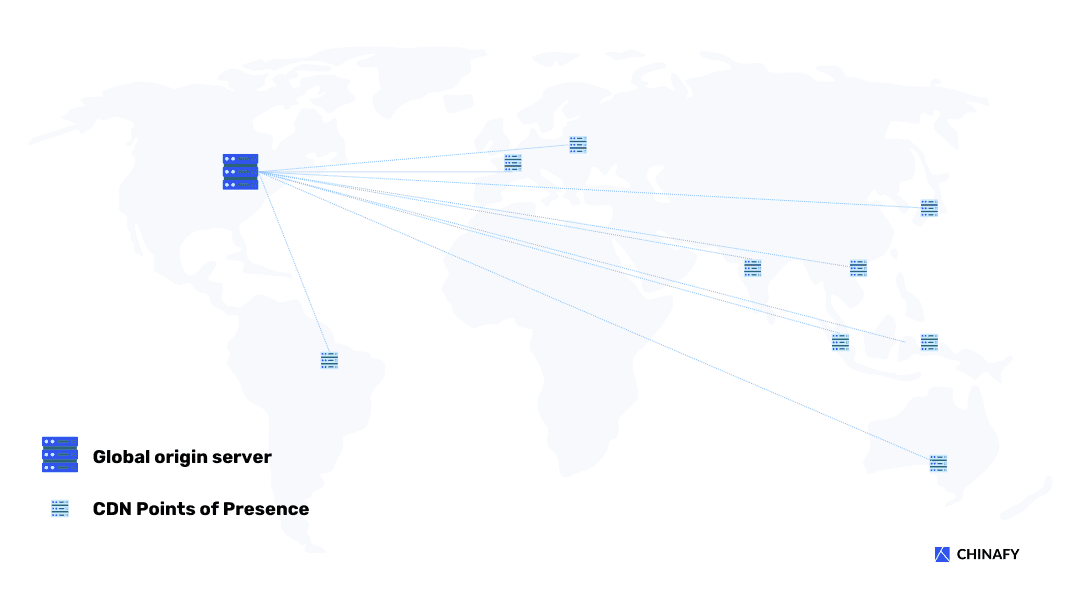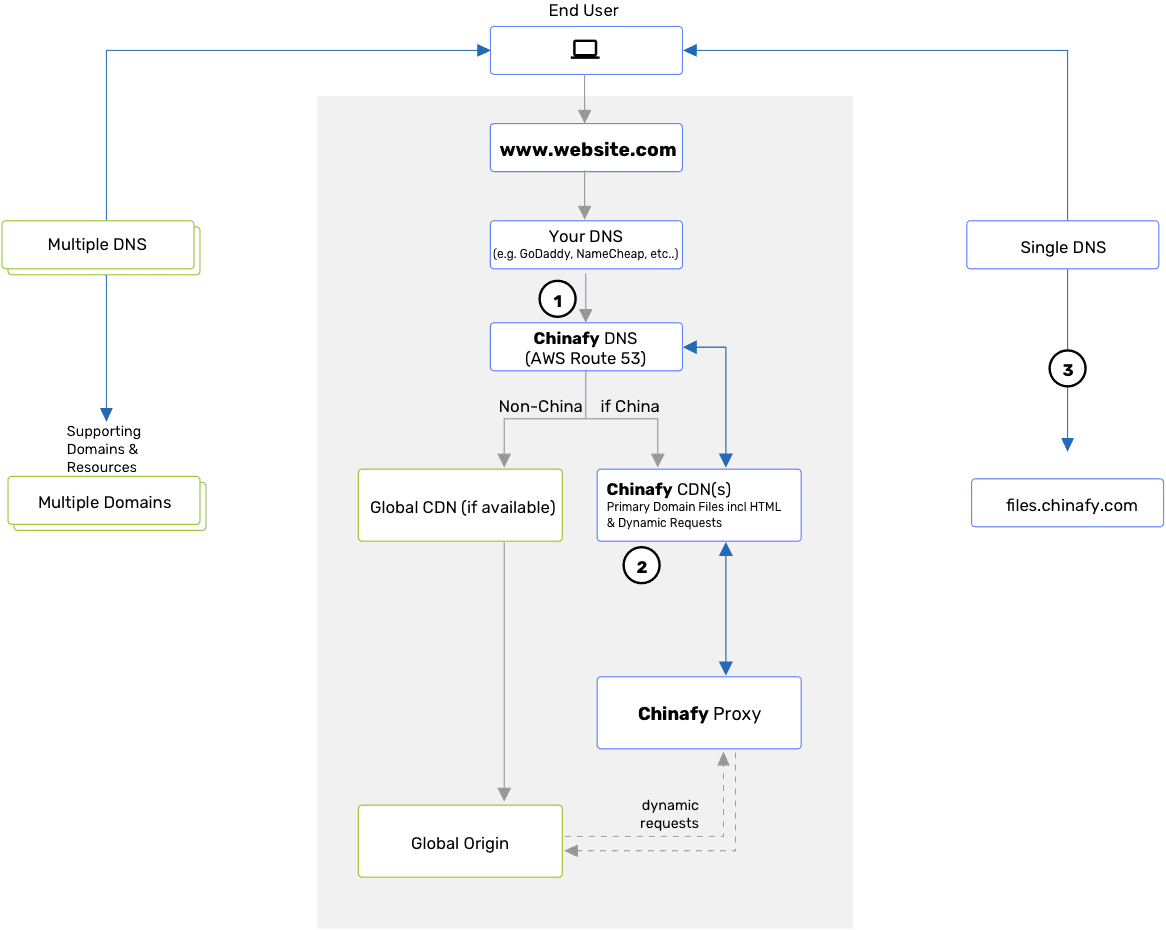1 - Expected post-Chinafy results
Choosing Between Multi-CDN and Single CDN for Your Website in China
Making your global website load fast and fully in China is a different ball game to the rest of the world. If you’re researching ways to deliver your website content to users in China with the same speed and reliability as the rest of the world, you’ve come to the right blog.
Regardless of where your website is hosted (within or outside of China), one decision to make is whether to use a single CDN (content delivery network) or adopt a multi-CDN strategy. Both options have their pros and cons, but which one is best suited for delivering content efficiently and reliably to users in China?
TL;DR If you want your website to perform well in China, a single CDN might not be enough due to limited coverage and infrastructure challenges. A multi-CDN strategy, which uses multiple providers to optimize content delivery, offers better performance and reliability by distributing traffic across different networks.
However, both strategies only address part of the problem. Website performance in China is also affected by blocked third-party resources and other local restrictions. A solution like Chinafy works alongside your CDN(s) to tackle these issues, leading to faster load times and as-expected functionality for users in China, without touching your global setup.
In this article, we’ll explore whether you need a CDN to make your website work in China, the differences between multi-CDN and single-CDN strategies, and how to choose the right approach to optimize your website's performance in China.
What is a CDN?
Before diving into the details, let’s quickly recap what a CDN is.
A CDN (Content Delivery Network) is a network of servers strategically distributed around the globe to store and deliver website content, such as images, videos, and scripts, to users from the nearest location. This helps reduce latency and improve loading speeds, especially for users who are far from the origin server.

So for global companies, using a CDN helps visitors from different regions access your website quickly. Without a CDN, a user in Australia trying to load a site hosted only in the U.S. would experience slower speeds because of the physical distance and network hops involved. CDNs solve this by distributing content to multiple locations worldwide, allowing users to load your site from the nearest available server.
So is China any different?
Do I need a CDN to make my website faster in China?
The short answer is yes – but there’s more to it.
Websites in China often face speed and functionality issues caused by:
Infrastructure setup (this includes your CDN)
Code and third-party resources
To resolve infrastructure issues, businesses can host their website in China or use a CDN to move their content closer to China.
However, many “global CDNs” lack Points of Presence (PoPs) in China, which means when a user accesses your website from China, the browser has to retrieve files from servers located outside of China, sometimes as far away as the US or Europe. This leads to slower load times, higher latency, or even timeouts, despite your site performing just fine in the rest of the world.
For industries regulated by the Chinese government, such as banking, pharmaceuticals, and finance, you may be required* to use a China-based CDN or host your website in China.
For non-regulated global businesses that are outside of China, it’s a choice*.
*Please note, this is not legal advice. Chinafy is a web performance platform, however we do have partners who can guide you on compliance for your website in China.
However, because onshore CDNs have servers within mainland China, there are prerequisites to using them, including:
Obtaining an ICP license
Establishing a local entity or partnering with a local provider
Registering your website with the Public Security Bureau (PSB)
Remaining compliant with China’s content regulations, such as data localization.
But before you dive head first into onshore hosting and localization, it’s good to understand that using a Chinese CDN alone isn’t a silver bullet to making your website accessible or functional from China. While it can improve loading times, CDNs don’t address code or file-based issues, which is where solutions like Chinafy come in (but more on this later).
So, should you opt for a multi CDN setup or stick to a single CDN provider?
Multi-CDN vs. Single-CDN: What’s the difference?
Single-CDN strategy
A single-CDN approach means relying on one CDN provider to distribute your content globally, including in China. This makes your life easier as you’re only working with a single provider but this also leads to reliance.
Here’s a quick rundown of the pros and cons of using a single CDN:
Pros:
Simplicity and speed: managing one CDN is straightforward with minimal administrative overhead, easier integration, quicker deployment and less potential for configuration errors.
Cost-effectiveness: due to reduced complexity in integration, single CDN strategies often result in lower operational costs, particularly for smaller websites.
Cons:
No PoPs within China: if you’re opting for a global CDN that lacks Points of Presence (PoPs) within China and has few near China, users in China may experience slower load times.
Reliance on one provider’s infrastructure: relying on one CDN means you’re vulnerable to outages or service disruptions in China, with no alternative routing options.
Limited flexibility: a single CDN strategy restricts your ability to re-route traffic when issues arise in China.
In short, a single CDN may be simpler and cheaper but comes with higher risks of poor performance in China.
Multi-CDN strategy
A multi-CDN strategy, on the other hand, involves using multiple CDN providers, each with its own network of PoPs. This can be particularly useful in China, where regional differences in infrastructure can impact performance. By leveraging multiple CDNs, you can route traffic dynamically to optimize delivery based on network conditions and ensure better performance for users in China.
Here’s are the main pros and cons of using a multi-CDN approach:
Pros:
Greater control: you can choose CDN providers with specific strengths in different regions. For China, this could mean selecting CDNs that excel in local performance.
Reduced risk: by distributing your content across multiple CDNs, you reduce the risk of service disruptions. If one CDN provider faces latency issues or downtime, your content can still be delivered through the remaining CDNs, ensuring uninterrupted service.
Improved performance: multi-CDN strategies can optimize content delivery by routing user requests to the best-performing CDN based on real-time performance metrics.
Cons:
More complex to manage: the more CDNs, the more effort to manage relationships, administration and integrations.
Potentially higher costs: using several CDN providers can lead to higher operational costs, both in terms of the services themselves and the resources required to manage them.
Requires expertise: configuring and managing a multi-CDN setup can require advanced knowledge of traffic routing and load balancing.
How to choose the right CDN strategy for China
Choosing between a single-CDN and multi-CDN strategy depends on factors like:
Budget: single-CDN setups are generally more cost-effective, whereas multi-CDN strategies offer more reliable performance, which can justify the higher cost for many businesses.
Performance needs: if your primary goal is to maximize performance and ensure the best possible user experience in China, a multi-CDN strategy might be the better choice due to its ability to optimize routing and handle regional variances.
Risk tolerance: if maintaining uninterrupted service is critical and you’re willing to invest in additional complexity and costs, a multi-CDN approach will give you superior reliability.
Technical expertise: single-CDN strategies are simpler to manage, while a multi-CDN strategy requires more monitoring and management.
Why multi-CDN is usually best for China visitors
A multi-CDN strategy can often be the better choice when you’re delivering content to users in China. Here are a few reasons why multi-CDN is often preferred for China:
No need to compromise your global site
With a multi-CDN approach, you can use a China-optimized CDN alongside a global CDN, so users get a fast and reliable experience wherever they are—both inside and outside of China.
Adapting to regional variability
China's unique infrastructure means performance can vary across different regions. A multi-CDN setup allows you to choose providers that excel in specific areas, ensuring consistent performance for users in both urban and rural China.
Network redundancy
By distributing traffic across multiple CDNs, you reduce the risk of downtime. If one CDN experiences slowdowns or outages, traffic is automatically rerouted to another, ensuring uninterrupted service.
Optimized performance
By combining multiple CDNs, you can take advantage of the strengths of different providers, ensuring that content is delivered from the best-performing network at any given time.
A worthwhile consideration
Even with a global CDN, China-specific CDN, or a combination, your site may still suffer performance issues in China. This is because CDNs only address part of the problem: infrastructure.
CDNs don’t resolve code- or file-based issues relating to blocked or restricted third-party resources - such as Google APIs, YouTube embeds, and social media elements - that could lead to your site still loading slowly or failing to load altogether.
Here’s where Chinafy steps in.
Chinafy: your CDN’s new best friend
Chinafy can work alongside your existing CDN(s) to automatically identify and resolve performance bottlenecks for China visitors on an ongoing basis. Using Smart Actions and rule-based optimizations, Chinafy can get your website performing on average up to 40% faster in China compared to using a near-China or China CDN alone.
The way it works: Chinafy generates a China-specific version of your site – under the same website URL – that visitors from China will be re-routed to, while your global site remains entirely unaffected.

Image source: Chinafy
The Chinafy process involves:
Optimizing third-party resources: Chinafy automatically identifies and resolves issues with third-party resources that are blocked or slow in China, replacing or removing them without impacting your global site.
Improving infrastructure: Chinafy works alongside your existing CDN(s) to optimize your website’s performance for China without requiring any changes to your global setup.
Continual synchronization: if you make changes to your global site, they automatically sync with the Chinafy-optimized version, minimizing management efforts.
Choosing between a multi-CDN and single-CDN approach for China depends on the complexity of your website, your traffic, and your performance goals. For larger websites with significant traffic from China, a multi-CDN strategy offers greater control, flexibility, and reliability. For smaller websites, a single-CDN provider with a strong China presence may be sufficient, although there are specific requirements to use a China-based CDN.
For an all-in-one solution that resolves infrastructure based issues as well as code-based roadblocks, send us your website today and we’ll send you more specific information about how we can help you.



1 - Expected post-Chinafy results






























